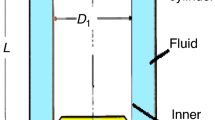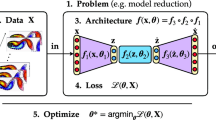Abstract
A review of representative research on tuned massed dampers (TMD) reported in journals in recent years is presented. TMDs are divided into four categories: conventional TMDs, pendulum TMDs (PTMDs), bi-directional TMDs (BTMDs), and tuned liquid column dampers (TLCDs).










Similar content being viewed by others
References
Adeli H, Kim H (2004) Wavelet-hybrid feedback least mean square algorithm for robust control of structures. J Struct Eng 130(1):128–137
Adeli H, Saleh A (1997) Optimal control of adaptive/smart bridge structures. J Struct Eng 123(2):218–226
Adeli H, Saleh A (1999) Control, optimization, and smart structures—high-performance bridges and buildings of the future. Wiley, New York
Adeli H, Sarma K (2006) Cost optimization of structures—fuzzy logic, genetic algorithms, and parallel computing. Wiley, West Sussex
Al-Saif KA, Aldakkan KA, Foda MA (2011) Modified liquid column damper for vibration control of structures. Int J Mech Sci 53(7):505–512
Aldemir U, Yanik A, Bakiogl MU (2012) Control of structural response under earthquake excitation. Comput-Aided Civ Infrastruct Eng 27(8):620–638
Almazan JL, De la Llera JC, Inaudi JA, Lopez Garcia D, Izquierdo LE (2007) A bidirectional and homogeneous tuned mass damper: a new device for passive control of vibrations. Eng Struct 29:1548–1560
Almazan JL, Espinoza G, Aguirre JJ (2012) Torsional balance of asymmetric structures by means of tuned mass dampers. Eng Struct 42:308–328
Amini F, Khanmohammadi HN, Abdolahi RA (2013) Wavelet PSO-based LQR algorithm for optimal structural control using active tuned mass dampers. Comput-Aided Civ Infrastruct Eng 28(7):542–557
Baraldi P, Canesi R, Zio E, Seraoui R, Chevalier R (2011) Genetic algorithm-based wrapper approach for grouping condition monitoring signals of nuclear power plant components. Integr Comput-Aided Eng 18(3):221–234
Bitaraf M, Hurlebaus S, Barroso LR (2012) Active and semi-active adaptive control for undamaged and damaged building structures under seismic load. Comput-Aided Civ Infrastruct Eng 27(1):48–64
Chabuk T, Reggia JA, Lohn J, Linden D (2012) Causally-guided evolutionary optimization and its application to antenna array design. Integr Comput-Aided Eng 19(2):111–124
Connor JJ (2003) Introduction to structural motion control. Prentice Hall/Pearson Education, Upper Saddle River
El-Khoury O, Adeli H (2013) Recent advances on vibration control of structures under dynamic loading. Arch Comput Methods Eng (accepted)
ENR (1977) Tuned mass dampers steady sway of skyscrapers in wind. Eng News-Rec 18:28–29
Fisco NR, Adeli H (2011) Smart structures: part I—active and semi-active control. Sci Iran, Trans A, Civ Eng 18(3):275–284
Fisco NR, Adeli H (2011) Smart structures: part II—hybrid control systems and control strategies. Sci Iran, Trans A, Civ Eng 18(3):285–295
Frahm H (1909) Device for damping vibrations of bodies. U.S. Patent 0989958
Gerges RR, Vickery BJ (2005) Optimum design of pendulum-type tuned mass dampers. Struct Des Tall Spec Build 14:353–368
Ghaemmaghami A, Kianoush R, Yuan XX (2013) Numerical modeling of dynamic behavior of annular tuned liquid dampers for applications in wind towers. Comput-Aided Civ Infrastruct Eng 28(1):38–51
Ghodrati Amiri G, Abdolahi Rad A, Khorasani M (2012) Generation of near-field artificial ground motions compatible with median predicted spectra using PSO-based neural network and wavelet analysis. Comput-Aided Civ Infrastruct Eng 27(9):711–730
Holmes JD (1995) Listing of installations. Eng Struct 17(9):608–683
Hsiao FY, Wang SS, Wang WC, Wen CP, Yu WD (2012) Neuro-fuzzy cost estimation model enhanced by fast messy genetic algorithms for semiconductor hookup construction. Comput-Aided Civ Infrastruct Eng 27(10):764–781
Huang MF, Tse KT, Chan CM, Lou WJ (2011) Integrated structural optimization and vibration control for improving wind-induced dynamic performance of tall buildings. Int J Struct Stab Dyn 11(6):1139–1161
Jafarkhani R, Masri SF (2011) Finite element model updating using evolutionary strategy for damage detection. Comput-Aided Civ Infrastruct Eng 26(3):207–224
Jiang X, Ma ZJ, Ren WX (2012) Crack detection from the slope of the mode shape using complex continuous wavelet transform. Comput-Aided Civ Infrastruct Eng 27(3):187–201
Kareem A, Kline S (1995) Performance of multiple mass dampers under random loading. J Struct Eng 121(2):348–361
Kim H, Adeli H (2001) Discrete cost optimization of composite floors using a floating point genetic algorithm. Eng Optim 33(4):485–501
Kim H, Adeli H (2004) Hybrid feedback-least mean square algorithm for structural control. J Struct Eng 130(1):120–127
Kim H, Adeli H (2005) Hybrid control of smart structures using a novel wavelet-based algorithm. Comput-Aided Civ Infrastruct Eng 20(1):7–22
Kim H, Adeli H (2005) Hybrid control of irregular steel highrise building structures under seismic excitations. Int J Numer Methods Eng 63(12):1757–1774
Kim H, Adeli H (2005) Wind-induced motion control of 76-story benchmark building using the hybrid damper-tuned liquid column damper system. J Struct Eng 131(12):1794–1802
Lavan O, Daniel Y (2013) Full resources utilization seismic design of irregular structures using multiple tuned mass dampers. Struct Multidiscip Optim 48(3):517–532
Lei Y, Wu DT, Lin Y (2012) A decentralized control algorithm for large-scale building structures. Comput-Aided Civ Infrastruct Eng 27(1):2–13
Lin J-L, Tsai K-C, Yu Y-J (2010) Coupled tuned mass dampers for the seismic control of asymmetric-plan buildings. Earthq Spectra 26(3):749–778
Lin CM, Ting AB, Hsu CF, Chung CM (2012) Adaptive control for MIMO uncertain nonlinear systems using recurrent wavelet neural network. Int J Neural Syst 22(1):37–50
Love JS, Tait MJ (2013) The influence of tank orientation angle on a 2D structure-tuned liquid damper system. J Vib Acoust 135(1):38–51
Marano GC, Quaranta G, Monti G (2011) Modified genetic algorithm for the dynamic identification of structural systems using incomplete measurements. Comput-Aided Civ Infrastruct Eng 26(2):92–110
Matta E, DeStefano A (2009) Robust design of mass-uncertain rolling-pendulum TMDs for the seismic protection of buildings. Mech Syst Signal Process 23:127–147
Mohebbi M, Joghataie A (2012) Designing optimal tuned mass dampers for nonlinear frames by distributed genetic algorithms. Struct Des Tall Spec Build 21(1):57–76
Nagase T (2000) Earthquake records observed in tall buildings with tuned pendulum mass damper. In: Proceedings from the 12th world conference on earthquake engineering, Auckland, New Zealand
Nagase T, Hisatoku T (1992) Tuned-pendulum mass damper installed in Crystal Tower. Struct Des Tall Spec Build 1:35–56
Nigdeli SM, Boduroğlu MH (2013) Active tendon control of torsionally irregular structures under near-fault ground motion excitation. Comput-Aided Civ Infrastruc Eng 28(9):718–736
Patil VB, Jangid RS (2011) Optimum multiple tuned mass dampers for wind excited benchmark building. J Civ Eng Manag 17(4):540–557
Plevris V, Papadrakakis M (2011) A hybrid particle swarm—gradient algorithm for global structural optimization. Comput-Aided Civ Infrastruct Eng 26(1):48–68
Putha R, Quadrifoglio L, Zechman E (2012) Comparing ant colony optimization and genetic algorithm approaches for solving traffic signal coordination under oversaturation conditions. Comput-Aided Civ Infrastruct Eng 27(1):14–28
Sakai F, Takaeda S, Tamaki T (1989) Tuned liquid column damper—new type device for suppression of building vibrations. In: Proceedings of international conference on high-rise buildings, Nanjing, China, vol 2, pp 926–931
Sarkar A, Gudmestad OT (2013) Pendulum type liquid columns damper (PLCD) for controlling vibrations of a structure—theoretical and experimental study. Eng Struct 49:221–233
Sarma K, Adeli H (2000) Fuzzy discrete multicriteria cost optimization of steel structures. J Struct Eng 126(11):1339–1347
Sarma KC, Adeli H (2001) Bi-level parallel genetic algorithms for optimization of large steel structures. Comput-Aided Civ Infrastruct Eng 16(5):295–304
Sarma KC, Adeli H (2002) Life-cycle cost optimization of steel structures. Int J Numer Methods Eng 55(12):1451–1462
Setareh M, Ritchey JK, Baxter AJ, Murray TM (2006) Pendulum tuned mass dampers for floor vibration control. J Struct Eng 20(1):64–73
Sirca GF Jr., Adeli H (2012) System identification in structural engineering. Sci Iran, Trans A, Civ Eng 19(6):1355–1364
Tait MJ, Isyumov N, Damatty AA (2008) Performance of tuned liquid dampers. J Eng Mech 134(5):417–427
Tao H, Zain JM, Ahmed MM, Abdalla AN, Jing W (2012) A wavelet-based particle swarm optimization algorithm for digital image watermarking. Integr Comput-Aided Eng 19(1):81–91
Wong KKF, Harris JL (2012) Seismic damage and fragility analysis of structures with tuned mass dampers based on plastic energy. Struct Des Tall Spec Build 21(4):296–310
Xiang J, Liang M (2012) Wavelet-based detection of beam cracks using modal shape and frequency measurements. Comput-Aided Civ Infrastruct Eng 27(6):439–454
Yalla S, Kareem A (2000) Optimum absorber parameters for tuned liquid column dampers. J Struct Eng 126(8):906–915
Author information
Authors and Affiliations
Corresponding author
Rights and permissions
About this article
Cite this article
Gutierrez Soto, M., Adeli, H. Tuned Mass Dampers. Arch Computat Methods Eng 20, 419–431 (2013). https://doi.org/10.1007/s11831-013-9091-7
Received:
Accepted:
Published:
Issue Date:
DOI: https://doi.org/10.1007/s11831-013-9091-7




